Can You 3d Print a Water Bottle? Yes!
You can 3D print a water bottle using food-safe filaments like PETG or PLA. Make sure you calibrate your 3D printer accurately, focusing on bed leveling and nozzle height.
Use CAD software to design for ergonomic handling, leak-proof seals, and precise threading. Employ technologies like FDM for durability or SLA for high-resolution finishes.
Post-process and sterilize the bottle to eliminate any contaminants. Monitor environmental and energy impacts, prioritizing sustainability.
Traditional methods like injection molding are better for mass production, but 3D printing excels in customization and rapid prototyping. To explore detailed steps, continue gaining insights.

Key Takeaways
Understanding 3D Printing Basics
To successfully 3D print a water bottle, you must first grasp the fundamental principles of additive manufacturing. This process involves creating an object layer by layer from a digital model.
You’ll need to understand the slicing software, which translates your 3D model into a series of thin, printable layers.
Precision is essential; each layer must align perfectly to guarantee structural integrity. Calibration of your 3D printer is another key aspect. It involves adjusting the bed leveling and nozzle height for best extrusion.
Familiarize yourself with terms like FDM (Fused Deposition Modeling) and STL (Standard Tessellation Language) files.
Suitable Materials for 3D Printing
When 3D printing a water bottle, it’s crucial to consider using food-safe filament options such as PETG and PLA, which comply with FDA regulations.
Evaluate the material strength to ensure that the water bottle can withstand the rigors of daily use and pressure changes.
Don’t forget to strike a balance between durability and safety when choosing the filament for your 3D printed water bottle.
Food-Safe Filament Options
Selecting the appropriate food-safe filament for 3D printing a water bottle is crucial, as it guarantees the printed object is safe for contact with consumables and meets FDA compliance standards.
You should consider PLA, PETG, and PP filaments. PLA (Polylactic Acid) is biodegradable and generally recognized as safe (GRAS) by the FDA, though it requires a food-safe coating post-printing.
PETG (Polyethylene Terephthalate Glycol) offers excellent chemical resistance and is often used in food containers. PP (Polypropylene) is another viable option due to its high melting point and chemical inertness.
Make sure the filament is specifically labeled as food-safe and verify that no harmful additives are included.
Always validate with manufacturer specifications and post-processing guidelines for ultimate safety.
Material Strength Considerations
After verifying that your filament is food-safe, you must also consider the material’s strength to guarantee the durability and functionality of your 3D-printed water bottle.
PLA, while commonly used, lacks the durability required for a water bottle that endures daily use. PETG offers a better balance of strength and flexibility, making it an ideal candidate.
ABS, known for its robustness, can withstand higher temperatures but may release harmful chemicals. Nylon, with its superior tensile strength and impact resistance, is another excellent option.
Additionally, confirm proper layer adhesion and infill density to enhance structural integrity. By selecting a material that balances strength, flexibility, and safety, you’ll create a reliable and long-lasting water bottle.
Designing a Water Bottle
When designing a 3D-printed water bottle, you’ll need to prioritize the bottle’s dimensions to guarantee ergonomic handling and sufficient capacity.
Additionally, integrate features that enhance the seal integrity to ensure a leak-proof design, such as O-ring grooves or precision-threaded caps.
Using CAD software, you can fine-tune these elements to meet both functional and aesthetic criteria.
Choosing Bottle Dimensions
Determining the most suitable dimensions for your 3D-printed water bottle involves analyzing factors such as volume requirements, ergonomic considerations, and printer capabilities.
First, decide on the bottle’s capacity, which typically ranges from 500ml to 1L. Consider how the bottle feels in hand and make sure it’s easy to grip and drink from.
Evaluate your 3D printer’s build volume to confirm it can accommodate your design.
Key considerations include:
- Volume Capacity: Guarantee your bottle meets daily hydration needs.
- Ergonomics: Design for best grip and ease of use.
- Printer Constraints: Verify the dimensions match your printer’s build space.
Ensuring Leak-Proof Design
To ensure your 3D-printed water bottle remains leak-proof, focus on designing secure seal interfaces and precise threading for caps and closures. Start by ensuring your threads have an accurate pitch and depth to facilitate an airtight seal.
Utilize O-rings or gaskets for enhanced sealing, especially around the neck and cap area. Choose materials known for their flexibility and durability, such as TPU, to accommodate the pressure changes within the bottle.
Implement ribbing or interlocking mechanisms to provide additional security against leaks.
Conduct pressure tests to verify the integrity of your design. Keep in mind, even minor deviations in your CAD model can lead to significant leaks.
As such, precision in your design and print settings is paramount for a successful, leak-proof water bottle.
3D Printing Technologies
Among the various 3D printing technologies available, Fused Deposition Modeling (FDM) and Stereolithography (SLA) are the most widely used in creating functional prototypes like water bottles.
FDM uses a thermoplastic filament that’s melted and extruded layer by layer, making it ideal for durable and functional parts.
SLA, on the other hand, employs a photosensitive resin cured by a UV laser, resulting in high-resolution, smooth surface finishes.
Key considerations include:
- Layer Resolution: FDM typically offers 50-200 microns, while SLA provides finer details at 25-100 microns.
- Material Properties: FDM materials are robust but less detailed; SLA resins can be more brittle but highly precise.
- Post-Processing: SLA usually requires more post-processing steps like washing and curing.
Understanding these nuances is essential for your project’s success.
Safety Considerations
Safeguarding safety in 3D printing a water bottle involves several critical considerations, including the selection of food-safe materials and the proper handling of chemicals. You should use FDA-approved filaments, such as PETG or PLA, to avoid contamination.
Verify that your printer’s components, like nozzles and extruders, are made from non-toxic materials.
Handle resins and solvents with care, using appropriate PPE like gloves and masks to prevent inhalation or skin contact. Implement proper ventilation to mitigate the risk of fume exposure.
Sterilize the printed bottle post-production to eliminate residual contaminants. Regularly calibrate and maintain your 3D printer to ensure consistent quality and safety. By adhering to these guidelines, you can safely produce a functional and hygienic water bottle. Additionally, consider testing the bottle with different liquids to ensure durability and safety under various conditions. Just as boiling water in stainless steel helps eliminate bacteria, proper sterilization of your printed bottle will maintain hygiene. Implementing these best practices will enhance the longevity and reliability of your 3D-printed water bottle.
Durability and Testing
Testing the durability of your 3D-printed water bottle involves subjecting it to stress tests, drop tests, and thermal cycling to evaluate its structural integrity and performance under various conditions.
You’ll need to confirm the material can withstand repeated handling and environmental stressors.
Employ finite element analysis (FEA) to predict mechanical behavior under different loads. Conduct a series of controlled experiments:
- Stress Tests: Apply incremental pressure until deformation or failure occurs.
- Drop Tests: Drop the bottle from various heights to assess impact resistance.
- Thermal Cycling: Expose the bottle to alternating high and low temperatures to test for material fatigue and thermal expansion.
These tests provide essential data on the bottle’s robustness and longevity, ensuring reliability for everyday use.
Environmental Impact
Evaluating the environmental impact of your 3D-printed water bottle involves analyzing material sustainability, energy consumption during printing, and the end-of-life recyclability of the bottle.
When selecting filament, opt for biodegradable options like PLA, which offers reduced ecological footprint.
Monitor energy usage closely; 3D printers can be power-intensive, particularly during prolonged print cycles.
Additionally, assess the recyclability of your printed bottle. While some filaments are recyclable, others aren’t, complicating waste management.
Consider the full lifecycle: from raw material extraction to eventual disposal.
By focusing on energy-efficient printers and sustainable materials, you can mitigate environmental impact.
Comparing With Traditional Methods
When comparing 3D printing a water bottle to traditional manufacturing methods, you’ll find significant differences in material efficiency, production speed, and customization capabilities.
Traditional methods like blow molding and injection molding are optimized for mass production but often result in material waste and longer setup times.
In contrast, 3D printing offers:
- Material Efficiency: Additive manufacturing minimizes waste by using only the necessary material, unlike subtractive methods.
- Production Speed: While setup for traditional methods is time-consuming, 3D printing can produce a prototype within hours.
- Customization: 3D printing allows for intricate, bespoke designs without altering the manufacturing process, ideal for limited runs or unique specifications.
Conclusion
In your hands, the 3D-printed water bottle symbolizes the convergence of modern technology and environmental consciousness.
By leveraging precise 3D printing techniques and selecting safe, durable materials, you’re not just creating a vessel—you’re crafting a demonstration of innovation.
Remember, each layer of filament represents a step toward reducing waste and embracing sustainable practices.
With this blend of design precision and technical acumen, you’re pioneering a future where functionality meets responsibility.




